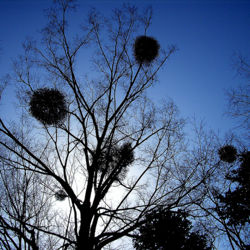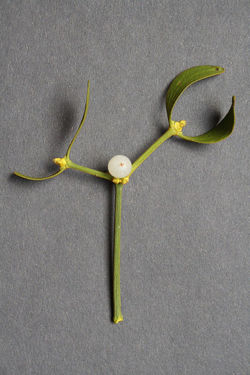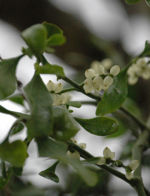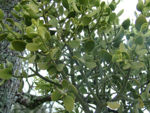Mistletoe
| Mistletoe |
|---|

|
| Scientific Classification |
|
| Genera |
|
A mistletoe is any of the species of flowering plants belonging to the taxonomic family Viscaceae which was created by God on Day 3 of Creation. They are parasitic plants, digging its specialized roots deep into the water sources of its prey (usually coniferous trees). Mistletoe spreads very quickly throughout a small area. Mistletoe is actually not the frilly Christmas plant we all thought, but actually started out in European households as a symbol of peace from the Wiccan community and as a symbol of fertility.
Anatomy and Ecology
Mistletoe is actually a parasitic plant. They have long roots that bury themselves deep into the living tissues of their hosts native to the Pacific Northwest. There are two very distinct variations of the mistletoe plant: true mistletoe and dwarf mistletoe. The true mistletoes can feed off of most large, deep rooted plants and are capable of overtaking the whole plant and feeding from their water sources. The dwarf mistletoe feeds from mostly coniferous plants and usually attack the branches of the tree.
Within the U.S. Mistletoe is mainly found in the California region, but can also be found in other southern areas of America. The mistletoe likes growing mainly on hardwood plants.
Mistletoe is a toxic plant in large quantities. The main avenues of the poison come from the "leafy shoots" of the mistletoe plant and are most harmful to weaker individuals such as children or pets. For the most part mistletoe shouldn’t be ingested by any person for any reason.[1]
Reproduction
Mistletoe seeds are spread mostly by birds. The seeds are each equipped with a sticky coating called viscin (which has cellulose stands and mucopolysaccharides inside of it), and the seeds are located inside the colorful drupes (or fruits of the mistletoe plant). The bird eats the berries and the sticky seeds attach themselves to the beak of the bird, causing an annoyance until the bird wipes its beak off onto a branch of its perch. The sticky seeds then begin to grow their parasitic roots deep inside the branches of the tree. Seeds can also be spread through the birds excrement landing on a branch of it's appropriate "habitational" tree.[2]
The Christmas Tradition
The tradition of hanging mistletoe in one's house is a European tradition. The mistletoe plant was hung in the house to ward off evil spirits. They were hung in doorways to keep witches away. Around Christmas time mistletoe would be given to the first cow to have a baby (for good luck). A Scandinavian tradition was to hang mistletoe as a peace offering, under which enemies could kiss and make up.[3]
Gallery
Related References
- Viscum album Wikipedia
- Mistletoe Extracts National Cancer Institute
- Mistletoe (history of the tradition) Garden Line
- Mistletoe FAQ Rocky Mountain Research Station







